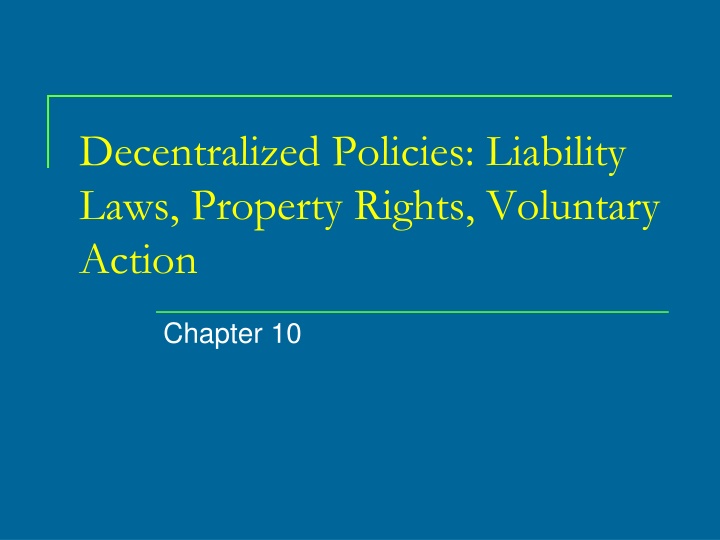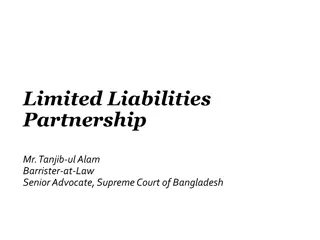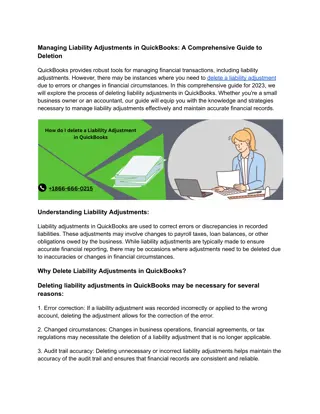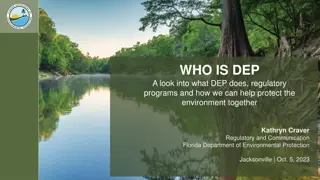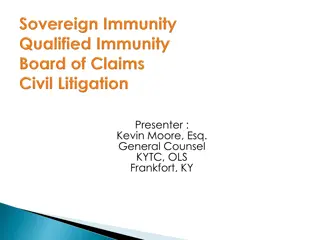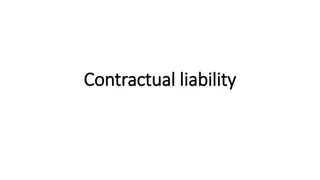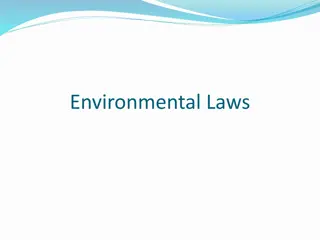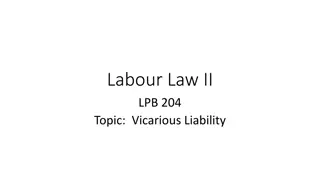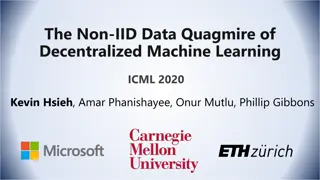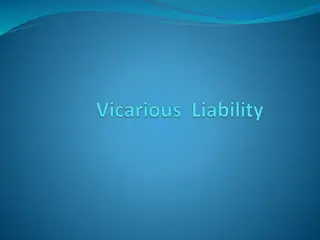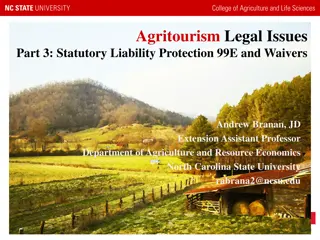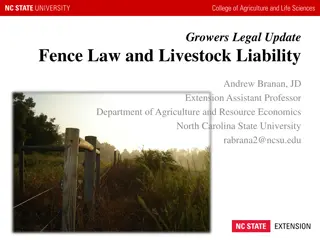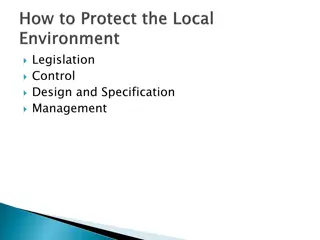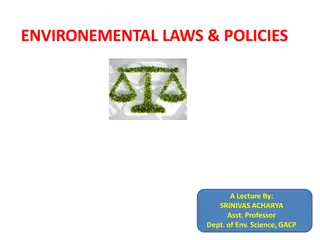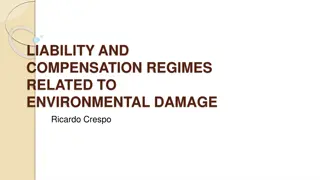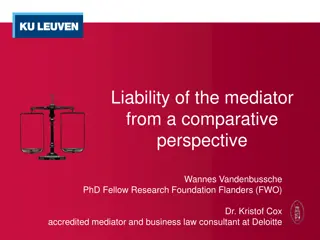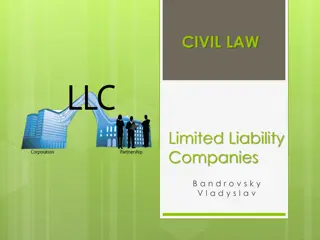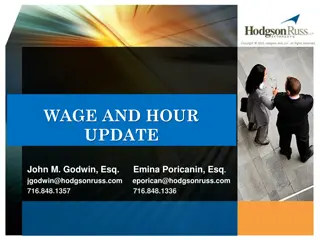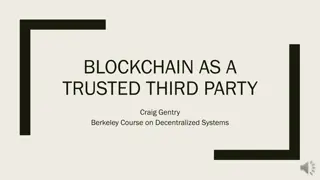Decentralized Policies and Liability Laws in Environmental Protection
Explore the concept of decentralized policies in managing environmental pollution, focusing on liability laws, property rights, and voluntary actions. Discover how decentralized approaches offer advantages in addressing environmental externalities and how liability laws can change incentives for polluters to internalize external effects.
Download Presentation

Please find below an Image/Link to download the presentation.
The content on the website is provided AS IS for your information and personal use only. It may not be sold, licensed, or shared on other websites without obtaining consent from the author.If you encounter any issues during the download, it is possible that the publisher has removed the file from their server.
You are allowed to download the files provided on this website for personal or commercial use, subject to the condition that they are used lawfully. All files are the property of their respective owners.
The content on the website is provided AS IS for your information and personal use only. It may not be sold, licensed, or shared on other websites without obtaining consent from the author.
E N D
Presentation Transcript
Decentralized Policies: Liability Laws, Property Rights, Voluntary Action Chapter 10
Incompatible Uses By "decentralized" policies we mean policies that essentially allow the individuals involved in a case of environmental pollution to work it out themselves. Two industrial plants around the lake. One processes food. water of the lake is an important input in its operation. The other is an industrial operation that uses the lake for waste disposal. A decentralized approach to finding the efficient level of ambient water quality in the lake is simply to let the two plants work it out between themselves. 2
Decentralized Approaches: Advantages Because the parties involved are the ones producing and suffering the environmental externalities, they have strong incentives to seek out solutions to the environmental problems. The people involved may be the ones with the best knowledge of damages and abatement costs; therefore, they may be best able to find the right balance among them, that is, to find efficient solutions. 3
Liability Laws To be liable for some behavior is to be held responsible for whatever untoward consequences result from that behavior. Compensation requires that those causing the damage compensate those damaged in amounts appropriate to the extent of the injury. 4
Changing Incentives Make polluters liable for the damages they cause. The purpose is to compensate people after they have been injured, and get would-be polluters to make careful decisions. Knowing that they will be held liable for environmental damages in effect internalizes what would otherwise be ignored external effects. 5
Internalizing the Externality Suppose common law requires polluters to compensate those damaged in an amount equal to the damages caused. The effect of the law is to internalize the environmental damages that were external before the law. Damages become costs that polluters will have to pay and therefore will want to take into account when deciding on emissions. 6
Efficient? A liability system could lead this polluter to emission level e*. It would not require any centralized control authorities to intervene and mandate emission reductions. It requires rather a system of liability laws that would permit those damaged by pollution to be compensated for damages suffered. 8
Solving for e*? Liability appears to address the incentive question as well as the question of compensating those who are damaged. It may solve the problem of determining just where e* is along the emission axis. But whether this is actually true or not depends on the legal process common law or statute through which the amount of liability and compensation is established. 9
Common Law Common-law systems rely on court proceedings in which plaintiffs and defendants meet to make claims and counterclaims, and in which juries often are called on to decide questions of fact and amounts of compensation. Judgments normally are based on precedent established from similar cases in the past. 10
Strict Liability and Negligence A variety of legal doctrines related to nuisance and liability have developed over time. In the United States, the law now recognizes the difference between strict liability, which holds people responsible for damages regardless of circumstances, and negligence, which holds them responsible only if they did not take appropriate steps to avoid damage. 11
Difficult Hurdles Plaintiff must establish a direct causal link between the pollution and the damage. Must show that the polluting material was a direct cause of their damage, The material was came from the specific defendant that appears in court. Without being able to trace a polluting substance to specific defendants, those who have been damaged by it may be unable to obtain compensation. 12
Transaction Costs Transactions costs apply to liability systems where plaintiffs and defendants are competing in a court of law to determine the question of liability and the appropriate amounts of compensation. Complicated scientific questions often are involved, and judges and juries may find it virtually impossible to sort them out clearly. 13
Statutes Legislation may require compensation when a polluter causes damage. In a system where victims are free to sue particular companies for compensation of pollution-related disease, there is presumably a direct incentive for polluters to take steps to reduce their potential liability. The laws can provide the correct incentives only if the compensation approaches the actual amounts of damage. 14
Property Rights The case of a small lake that one firm used for waste disposal and another for a water supply. Which one of the firms is really causing damage and which firm is the one suffering damages? The problem may come about simply because it is not clear who has the initial right to use the services of the lake; that is, who effectively owns the property rights to the lake. 15
Property Rights to the Lake When a resource has no owner, nobody has a very strong incentive to see to it that it is not over exploited or degraded in quality. The lake could be owned either by the polluting firm or by the firm using it for a water supply. How does this choice affect the level of pollution in the lake? Would it not lead to zero emissions if owned by the one firm and uncontrolled emissions if owned by the other? 16
Will Ownership Affect the Allocation of Resources? Look again at Figure 10-1. Suppose the marginal damage function refers to all the damages suffered by the brewery call this Firm A. Assume the marginal abatement cost curve applies to the firm emitting effluent into the lake call this one Firm B. Is it possible that the same quantity of emissions will result in either case? 17
Case I In the first case, suppose that Firm A owns the lake. In this case Firm B would have to buy permission from Firm A to place its wastes in the lake. Any payment lower than marginal abatement costs (a + b) but higher than marginal damages (a) would make both parties better off. 18
Case II Firm B may use the lake any way it wishes. Suppose that emissions initially are at e1. Firm B is initially devoting no resources at all to emissions abatement. At this point marginal damages are $r, whereas marginal abatement costs are nil. The straightforward thing for Firm A to do is to offer Firm B some amount of money to reduce its effluent stream. They could continue to bargain over the marginal unit as long as marginal damages exceeded marginal abatement costs. Firm B would be better off by reducing its emissions for any payment in excess of its marginal abatement costs. 20
Coase Theorem So, in this little example, if property rights over the environmental asset are clearly defined, and bargaining among owners and prospective users is allowed, the efficient level of effluent will result irrespective of who was initially given the property right. 21
Efficient Level of Environmental Quality The wider implication is that by defining private property rights, we can establish the conditions under which decentralized bargaining can produce efficient levels of environmental quality. This has led some people to recommend widespread conversion of natural and environmental resources to private ownership as a means of achieving their efficient use. 22
Rules and Conditions In order for a property rights approach to work right that is, to give us something approaching the efficient level of environmental pollution essentially three main conditions have to be met: 1) Property rights must be well defined, enforceable, and transferable. 2)There must be a reasonably efficient and competitive system for interested parties to come together and negotiate about how these environmental property rights will be used. 3) There must be a complete set of markets so that private owners may capture all social values associated with the use of an environmental asset. 23
Transaction Costs The efficient use of the lake depended on negotiations and agreement between the two interested firms. Negotiating costs, together with the costs of policing the agreement, could be expected to be fairly modest. Suppose Firm A is replaced with a community of 50,000 people. Suppose that instead of one polluting firm there are 1,000 polluting firms. 24
Absence of Markets For private property institutions to ensure that an environmental asset is put to its best use, the process also must work in such a way that the owner is able to capture the full social value of the resource in that use. Suppose you own a small island in the Florida Keys. There are two possible uses: Develop a resort hotel or devote it to a wildlife refuge. 25
Free Riders One role for public authorities might be to create the demand side for such a market. Paying landowners an amount equal to the wider ecological value of the land, provided these ecological values were not impaired by the landholders' use of the land. Conservation Easements Endangered Species Act? 26
Markets for Green Goods Many people are willing to pay a little extra for improvements in environmental quality. Firms that respond to this demand can hope to gain market share and increased profits. E.g., Toyota Prius. 27
Voluntary Action By voluntary action we mean cases where individuals (including individual firms) engage in pollution-control behavior in the absence of any formal, legal obligation to do so. There are many who feel that programs based on voluntary restraint can be used quite effectively. One of the key issues is establishing the initial conditions that will motivate voluntary pollution reductions. 29
Moral Suasion A classic case of moral suasion is the Smokey Bear (and now Woodsy Owl) effort of the National Forest Service, a publicity campaign aimed at getting people to be more sensitive about littering in the woods and about avoiding things that would raise the risk of forest fires. 30
Civic Virtue In the early days of recycling, communities often mounted voluntary efforts, where appeals were made on the basis of civic virtue. 31
Informal Community Pressure Communities can put informal pressure on polluters to reduce their emissions. It is informal because it is not exercised through statutory or legal means, and it is pressure because it attempts to inflict costs on those who are responsible for excessive pollution. The costs in this case are in terms of such things as loss of reputation and sales. 32
Duke Faculty Michael Munger reports that professors at Duke University feel peer pressure to purchase hybrids, like the Toyota Prius. 33
Summary In theory, the threat of liability can lead potential polluters to internalize what would ordinarily be external costs. By weighing relative compensation and abatement costs, polluters would be brought to efficient emission levels. While liability doctrines may work well in simple cases of pollution where few people are involved and cause- and-effect linkages are clear, they are unlikely to work reliably in the large-scale, technically complicated environmental problems of contemporary societies. 36
Summary Contd The institution of private property rights. Environmental externalities are problems only because ownership of environmental assets is often not clearly defined. By establishing clear property rights, owners and others who would like to use environmental assets for various purposes can negotiate agreements that balance the relative costs of different alternatives. 37
